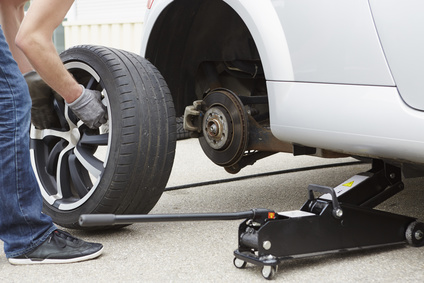A car breakdown is an annoying thing and can happen for a number of reasons. While you can often can get through tire damage with a spare or self-sealing tire, an empty gas tank or engine failure is a bigger problem. If you're protected by an auto club, you can call on their breakdown service. For this you'll dial a service hotline number, which you can do quickly thanks to Smartphone & Co. But in rural areas you may have no service. In that case a good old emergency call box can help you out, which can be found along interstate highways and other roads. The call is free. And if you have no membership in an auto club, you can get help which you then usually have to pay for. Car manufacturers sometimes offer a similar service that can be covered by insurance, depending on the probem.
|
Car breakdown service A number of auto clubs offer an ad-hoc membership in order to cover breakdown assistance when necessary. This is practical, so that the driver doesn't have to pay extra for the service. With ADAC, however, you have to show a membership that has been active for at least a day. But this doesn't mean that the "yellow angel" will refuse help to anyone else, such as when someone needs a small replacement part or some fuel - for a fee, of course. On-the-spot breakdown assistance like this is ideal but not always possible. Sometimes you can't avoid towing the car, which can cost quite a bit. Usually you have to pay in cash, and if you don't have enough with you, you need to tell the towing service up front so that you can stop by an ATM. |
 |
With a jack you can lift up a car, which makes repairs easier and lets you change a tire. There are several types of jacks, which mainly differ in their operation. When buying, don't just consider the price, but also the quality, since serious accidents can occur if the jack fails while working on a raised car. A GS symbol, TÜV seal, or CE designation are minimum requirements.
When searching for a suitable jack, you'll consider the weight of your vehicle, the axle height, and the method of operation. If you'll only need it occasionally, such as for changing between summer and winter tires, you can get by with a model for around 20 Euros. Mechanic hobbyists should invest a bit more; the pumps on hydraulic jacks will last longer, and more expensive rolling jacks are easier to use.
The simplest type is the diamond-shaped scissor jack, which can be bought for 10 Euros and up. With this model, you turn a crank to lift the car. You have to crank it for a while, but it doesn't require too much physical force. The scissor jack can be conveniently transported and is a popular item when a breakdown happens. A variation is a bottle jack with a pump arm.
|
Other common jack types are:
Car jacks should be used only on a level surface, with the parking brake engaged. Before use, the car should be shifted into first gear or "park" in an automatic transmission. |
 |
Hydraulic jacks
With hydraulic jacks there are differences between trolley and bottle jacks. Trolley jacks operate on oil pressure and are especially practical since they have four rollers, of which two are freely movable (like a shopping cart). They can be placed under the center of an axle, making the lifted car movable. Raising and lowering is done with a handle arm which operates the hydraulic pump. On the other end of the jack is a bowl-shaped plate (ideally with a rubber top) - this part makes contact with the car. Trolley jacks have one drawback: due to their weight they aren't very portable and are somewhat expensive.
Another option - even if it's not fundamentally better - is a bottle jack. This type can lift up to 30 tons and is thus stronger than any other jack. Professionals use pneumatic bottle jacks, though there are also hydraulic models. The high lifting capacity enables use for commercial/utility vehicles or RV's, even if the lifting height is very low.
Electric jacks
An alternative to manual, pneumatic, and hydraulic jacks is the electric jack. This is usually a scissor jack which has a motor. It is operated via the car's cigarette lighter, so there is no crank. There are different types of electric jacks, varying in power, lifting height, and of course price. Some models can also connect to the vehicle's battery.
Airbag jacks
An airbag jack uses a vehicle's exhaust gases to lift it. It's a kind of balloon made from tear-resistant plastic and has a tube or hose on one end. This is connected to the exhaust of the car, and the motor is started, which inflates the balloon. An airbag jack has a notable advantage: it's easily portable since it takes up little space, and it requires little physical effort to operate. Also, it's suitable for uneven surfaces that are difficult with traditional jacks. But the plastic airbag is susceptible to tears or failures, and if this happens during a breakdown, you're in trouble.
Loading ramps are used for loading (and unloading) one vehicle into another, when there is a height difference between the two vehicles. These must be very stable since usually heavy loads are being moved. They are made of different materials depending on the application, mainly steel or aluminum. Used with cars, large trucks, construction equipment, or motorcycles - loading ramps are a great convenience. When buying them, it's important to keep in mind not only their load capacity but also the ideal loading angle, and thus their length.
As opposed to wide access ramps in front of doors with steps for wheelchair users, loading ramps for vehicles consist of two pieces, one for each wheel. The distance between them can be fit to the width of the axle. A slight curvature makes loading even easier. There are also ramps with outer walls, designed to prevent the vehicle from sliding off the edge. Folding ramps have the advantage of not being so bulky, so they are easy to transport and take up less room.
The right loading ramp for every vehicle:
Passenger car loading ramps can fulfill another purpose than loading. Usually there are two ramps made of steel, on which the car drives. The tilted position of the vehicle makes it possible to access the undercarriage to locate or repair problems. Passenger car ramps are like a lifting platform, though you don't have access to the entire undercarriage. These are of course more affordable than an actual lifting platform.
Passenger car ramps vary in width. Typical models fit 195-, 225-, and 255-width tires. You can opt for height-adjustable models, which begin to resemble a lifting platform. In any case, they're better than a jack. Passenger car ramps are more affordable than you might think - it's usually not worth it to rent them.
Conventional loading ramps have a capacity of several hundred kilograms. That's enough to load motorcycles, quads, or other light vehicles. If you want to load a truck, you're usually dealing with heavier loads. So, truck loading ramps should hold up to several tons. This also plays a part in transporting commercial vehicles. When buying, check whether the load rating refers to one or two ramps. Block the wheels of the vehicle to be loaded with chocks, and be sure the ramps can't slip.
Construction equipment often weighs several tons. So it's important to use proper construction equipment loading ramps. They have to have a high load capacity. There are aluminum ramps suitable for this. Construction equipment loading ramps can support up to 20 tons and should be approached very carefully due to the heavy weights involved. The maximum angle should be 30%, or 16.5 degrees. The length of the ramps can be calculated with the following formula: height difference x 3.5. If the vehicle to be loaded has only one axle, the load capacity of the ramp usually amounts to around 80% of the listed value, since it usually refers to two-axle vehicles.
According to their application, loading ramps differ not only in length but also material. Usually they are made of aluminum or steel. The load capacity doesn't vary much - those with a capacity of more than 10 tons are often aluminum loading ramps. These have the advantage of lighter weight, making them easier to transport. They are available as folding ramps and in this case are kept on the loading area/bed of the transporting vehicle. They should not be confused with ramps that consist of several pieces joined together with joints and are extremely portable. Telescoping and suitcase-type ramps are aluminum loading ramps which can be stowed quite conveniently.